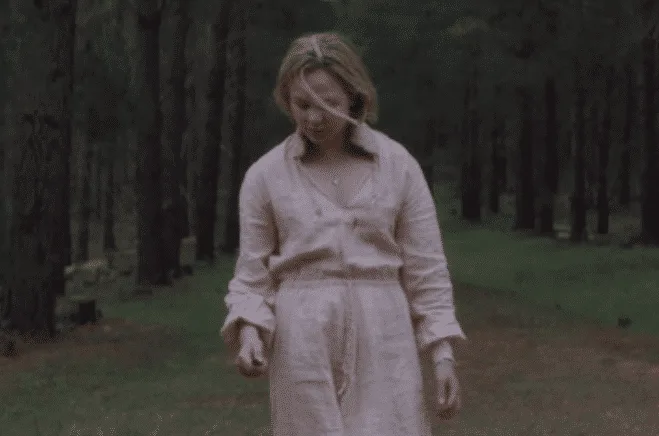
That said, the film makes quite the opening impact, with a cacophonous wall of sound and a nightmarish, stylised forest: a woman is fleeing, clearly distressed, and seeks refuge at a nearby guest house. In this place, the people who let her in behave in an oddly banal way, but when she tries to leave again, the tension (and that noise!) escalate further. So far, so familiar, you may think: women have been running through forests since time immemorial, and they’re usually in a bad way when they do. However, the unnatural angles and odd inmates of this area of woodland make the film feel surreal, rather than conventionally menacing. Furthermore – it transpires that this is all a dream, being had by the missing woman’s twin sister Maude (Adelaide Clemens). Cleo has disappeared, and Maude cannot shift vivid images of her sister being terrorised… somewhere. It has escalated to the point that it’s impacting upon her everyday life, so it’s recommended that she return home to Australia from med school in Germany to recuperate.
Awkward, awkward family exchanges ensue: her parents, it transpires, have already had a makeshift funeral for Cleo, but increasingly, Maude feels that her twin sister is still alive. Were they close? That’s complicated, but whatever was between them, it’s increasing its hold on the remaining twin. She also begins to appreciate the ripple effect that her sister’s disappearance has had on other people close to the case; the cop who failed to find her is now on an extended period of leave to recover, and Cleo’s fiance Ralph (Alex Russell) even says that he has shared some of the same feverish dreams about her. Cleo has preoccupied them all – but only Maude, as she soon begins to assert, can find out where she is, and she vows to bring her home. Together, these three begin to unpick the strange dream, aiming to trace Cleo to her last known whereabouts.
It’s actually pleasant not to be able to dismiss a film as ‘another sylvan horror’ or ‘another boondocks horror’ and so on, even though Rabbit has blended some elements of these together. It takes identifiable tropes – as we’ve already identified – but skews them, just enough that you can’t substantially guess where you’re going with all of this: if you can categorically say anything at all, then this is a mystery story, one where no one’s motivations are clear, but where everything is imbued with a low-key air of malevolence.

The eventual direction is largely a surprise too, although for a few moments towards the conclusion, another, notorious film’s influence made itself clearly felt. I’m struggling enough to review this film without giving the game away, and if I mention this film by title I’ll have done just that, so I’ll just say that for a short time, the film dances closer to something which has gone before. This is only a minor criticism, though, as Rabbit finds its way to a conclusion by unusual means throughout. It arrives at an interesting overarching theme with barely a drop of blood spilled, and Clemens believably enacts a range of emotions in increasingly bizarre situations, leading to an altogether heady, ethereal sensation.
Rabbit is the first new film I’ve seen in 2018, and I have a sneaking suspicion that it’ll remain one of my favourite films of this year. My attention never wavered, and to the end credits, I felt unable to settle into any expectations. This is an elaborate, artistic and unnerving fairy story: let’s hope to see it released very soon in 2018.
